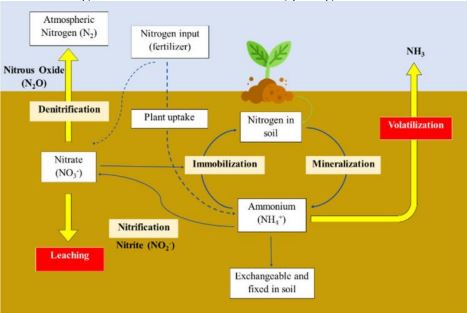Advancements in Precision Fertilization Technologies and Controlled-Dispersion Fertilizers for Sustainable Rice Cultivation
Keywords:
Sustainable Agricultural Development, Chemical Fertilizers, Coating Materials, Fertilization TechnologiesAbstract
World hunger remains a persistent challenge, necessitating sustainable agricultural strategies to address food demands. Efficient fertilizer use in rice cultivation is identified as a key contributor to sustainable agricultural development. The study introduces precision side-depth fertilization application technology for direct-seeded rice, optimizing fertilization processes and enhancing efficiency. The research explores various side-depth fertilizer application devices, focusing on their ability to seamlessly combine precision and depth. The proposed intermittent fixed-point precision method and device aim to meet side-depth fertilization requirements, addressing these challenges. In the context of increasing demand for food production, driven by population growth, the paper discusses the limitations of conventional fertilizers. Excessive use of chemical fertilizers results in challenges such as high production costs, resource depletion, and environmental pollution. To break this cycle, the study emphasizes deep fertilization technology, strategically applying fertilizers at specific depths during crop growth. The impact of fertilizer discharge devices on uniformity is crucial in mechanized farming. To enhance crop yields, the application of fertilizers is essential. Traditional manual fertilization methods in paddy rice cultivation are labor-intensive and inefficient. The study advocates for the mechanization of fertilizer application, considering the mechanical and physical properties of fertilizers. The research investigates the effects of particle size distribution and fertilizer concentration on flow parameters, contributing to the design of effective fertilizer application machines. The paper addresses the limitations of conventional fertilizers, emphasizing the environmental concerns associated with nitrogen-based fertilizers. Controlled-Dispersion Fertilizers (CDFs), particularly those with hydrogel coatings, emerge as a promising solution. The study categorizes coating materials into inorganic, synthetic polymer-based, natural polymer-based, and other organic materials, providing insights into their effectiveness. In conclusion, the paper underscores the significance of precision fertilization technologies, deep fertilization methods, and Controlled-Dispersion Fertilizers in promoting sustainable agricultural practices and addressing global food security.
References
R. A. Ramli, “Slow release fertilizer hydrogels: A review,” Polym. Chem., vol. 10, no. 45, pp. 6073–6090, Dec. 2019, doi: 10.1039/C9PY01036J.
E. M. Ahmed, “Hydrogel: Preparation, characterization, and applications: A review,” J. Adv. Res., vol. 6, no. 2, pp. 105–121, 2015, doi: 10.1016/J.JARE.2013.07.006.
S. Iqbal et al., “Chemical Fertilizers, Formulation, and Their Influence on Soil Health,” Microbiota Biofertilizers A Sustain. Contin. Plant Soil Heal., pp. 1–15, Jan. 2020, doi: 10.1007/978-3-030-48771-3_1.
D. Davidson and F. X. Gu, “Materials for sustained and controlled release of nutrients and molecules to support plant growth,” J. Agric. Food Chem., vol. 60, no. 4, pp. 870–876, Feb. 2012, doi: 10.1021/JF204092H.
H. Mansouri, H. Ait Said, H. Noukrati, A. Oukarroum, H. Ben youcef, and F. Perreault, “Advances in Controlled Release Fertilizers: Cost-Effective Coating Techniques and Smart Stimuli-Responsive Hydrogels,” Adv. Sustain. Syst., vol. 7, no. 9, p. 2300149, Sep. 2023, doi: 10.1002/ADSU.202300149.
D. W. Davidson, M. S. Verma, and F. X. Gu, “Controlled root targeted delivery of fertilizer using an ionically crosslinked carboxymethyl cellulose hydrogel matrix,” Springerplus, vol. 2, no. 1, pp. 1–9, 2013, doi: 10.1186/2193-1801-2-318.
M. Teodorescu, A. Lungu, P. O. Stanescu, and C. Neamţu, “Preparation and properties of novel slow-release NPK agrochemical formulations based on poly(acrylic acid) hydrogels and liquid fertilizers,” Ind. Eng. Chem. Res., vol. 48, no. 14, pp. 6527–6534, Jul. 2009, doi: 10.1021/IE900254B.
A. Shaviv, “Advances in controlled-release fertilizers,” Adv. Agron., vol. 71, pp. 1–49, 2001, doi: 10.1016/S0065-2113(01)71011-5.
“View of Conversion of Fertile Agricultural Land into Built-Up by Estimation of Pixel Based Land Surface Temperature (LST).” Accessed: Feb. 22, 2024. [Online]. Available: https://journal.50sea.com/index.php/IJASD/article/view/469/957
D. Skrzypczak et al., “Smart fertilizers-toward implementation in practice,” Smart Agrochem. Sustain. Agric., pp. 81–102, Jan. 2021, doi: 10.1016/B978-0-12-817036-6.00010-8.
J. Bendoraitiene, E. Lekniute-Kyzike, and R. Rutkaite, “Biodegradation of cross-linked and cationic starches,” Int. J. Biol. Macromol., vol. 119, pp. 345–351, Nov. 2018, doi: 10.1016/J.IJBIOMAC.2018.07.155.
Y. Shen et al., “Synthesis and characterization of double-network hydrogels based on sodium alginate and halloysite for slow release fertilizers,” Int. J. Biol. Macromol., vol. 164, pp. 557–565, Dec. 2020, doi: 10.1016/J.IJBIOMAC.2020.07.154.
P. Wen, Z. Wu, Y. Han, G. Cravotto, J. Wang, and B. C. Ye, “Microwave-Assisted Synthesis of a Novel Biochar-Based Slow-Release Nitrogen Fertilizer with Enhanced Water-Retention Capacity,” ACS Sustain. Chem. Eng., vol. 5, no. 8, pp. 7374–7382, Aug. 2017, doi: 10.1021/ACSSUSCHEMENG.7B01721.
H. Tian et al., “A one-step surface modification technique improved the nutrient release characteristics of controlled-release fertilizers and reduced the use of coating materials,” J. Clean. Prod., vol. 369, Oct. 2022, doi: 10.1016/J.JCLEPRO.2022.133331.
B. Azeem, K. Kushaari, Z. B. Man, A. Basit, and T. H. Thanh, “Review on materials & methods to produce controlled release coated urea fertilizer,” J. Control. Release, vol. 181, no. 1, pp. 11–21, May 2014, doi: 10.1016/J.JCONREL.2014.02.020.
B. Beig, M. B. K. Niazi, Z. Jahan, A. Hussain, M. H. Zia, and M. T. Mehran, “Coating materials for slow release of nitrogen from urea fertilizer: a review,” J. Plant Nutr., vol. 43, no. 10, pp. 1510–1533, Jun. 2020, doi: 10.1080/01904167.2020.1744647.
M. C. Camara, E. V. R. Campos, R. A. Monteiro, A. Do Espirito Santo Pereira, P. L. De Freitas Proença, and L. F. Fraceto, “Development of stimuli-responsive nano-based pesticides: Emerging opportunities for agriculture,” J. Nanobiotechnology, vol. 17, no. 1, Sep. 2019, doi: 10.1186/S12951-019-0533-8.
U. Surendran, M. Jayakumar, P. Raja, G. Gopinath, and P. V. Chellam, “Microplastics in terrestrial ecosystem: Sources and migration in soil environment,” Chemosphere, vol. 318, Mar. 2023, doi: 10.1016/J.CHEMOSPHERE.2023.137946.
“Recent advances in nitrogen and nano-nitrogen fertilizers for sustainable crop production: a mini-review | Chemical and Biological Technologies in Agriculture | Full Text.” Accessed: Feb. 17, 2024. [Online]. Available: https://chembioagro.springeropen.com/articles/10.1186/s40538-023-00488-3/tables/1
A. S. P. M. MF Seleiman, “Recycling sludge on cropland as fertilizer-advantages and risks,” Resour Conserv Recycl, vol. 155, p. 104647, 2020.
Y. I. L. R. R Rathnayaka, “Influence of urea and nano-nitrogen fertilizers on the growth and yield of rice (Oryza sativa L.) Cultivar ‘Bg 250,’” Biol Life Sci, vol. 5, pp. 7–17, 2018.
M. I. EL Ghobashi, “Effect of mineral and nano-nitrogen fertilizers on yield and its components of soybean and maize hybrids under intercropping system,” J Plant Prod, vol. 13, pp. 621–628, 2022.
M. L. S. L. L. X. Y. W. B Ni, “Environmentally friendly slow-release nitrogen fertilizer,” J Agric Food Chem, vol. 59, pp. 10169–10175, 2011.
P. Mahmoodi, “Comparison of the effect of nano urea and nono iron fertilizers with common chemical fertilizers on some growth traits and essential oil production of Borago officinalis L,” J Dairy Veter-Sci, vol. 2, pp. 1–4, 2017.
Z. S. O. Y. AR Anuar, “Contribution of legume-N by nodulated groundnut for growth of maize on an acid soil,” Soil Biol Biochem, vol. 27, pp. 595–601, 1995.
J. S. R. M. C Cherr, “Green manure approaches to crop production: a synthesis,” Agron J, vol. 98, pp. 302–319, 2006.
S. K. P. K. R. M. S. R. S Sheoran, “Nitrogen fixation in maize: breeding opportunities,” Theor Appl Genet, vol. 134, pp. 1263–1280, 2021.
K. Verma et al., “Silicon and nanosilicon mitigate nutrient deficiency under stress for sustainable crop improvement.” Academic Press, 2022.
M. X. S. G. H. L. S. H. B. W. Y Duan, “Long-term incorporation of manure with chemical fertilizers reduced total nitrogen loss in rain-fed cropping systems,” Sci Rep, vol. 6, p. 33611, 2016.
J. G. J. Olivier, A. F. Bouwman, K. W. Van Der Hoek, and J. J. M. Berdowski, “Global air emission inventories for anthropogenic sources of NOx, NH3 and N2O in 1990,” Environ. Pollut., vol. 102, no. 1, pp. 135–148, Jan. 1998, doi: 10.1016/S0269-7491(98)80026-2.
C. S. G. P. A. S. U. R. D. B. A. G. A. N Kottegoda, “Urea-hydroxyapatite nanohybrids for slow release of nitrogen,” ACS Nano, vol. 11, pp. 1214–1221, 2017.
F. A.-R. MKS Al-Saray, “Effect of Nano-Nitrogen and manufacture organic fertilizer as supplementary fertilizer in the yield and its component for three synthetics of maize (Zea mays L.),” Plant Arch, vol. 19, pp. 1473–1479, 2019.
T. Attia and N. Elsheery, “Nanomaterials: scope, applications, and challenges in agriculture and soil reclamation.” Springer, 2020.
E. A.-M. HWA Al-juthery, “Effect of urea and nano-nitrogen fertigation and foliar application of nano-boron and molybdenum on some growth and yield parameters of potato,” QJAS Al-Qadisiyah J Agric Sci, vol. 10, pp. 253–263, 2020.
J. Bremner, “Sources of nitrous oxide in soils,” Nutr Cycl Agroecosyst, vol. 49, p. 7, 1997.
O. Samaké, T. J. Stomph, M. J. Kropff, and E. M. A. Smaling, “Integrated pearl millet management in the Sahel: Effects of legume rotation and fallow management on productivity and Striga hermonthica infestation,” Plant Soil, vol. 286, no. 1–2, pp. 245–257, Aug. 2006, doi: 10.1007/S11104-006-9041-3/METRICS.
K. Ann Bybee-Finley, S. B. Mirsky, and M. R. Ryan, “Crop Biomass Not Species Richness Drives Weed Suppression in Warm-Season Annual Grass–Legume Intercrops in the Northeast,” Weed Sci., vol. 65, no. 5, pp. 669–680, Sep. 2017, doi: 10.1017/WSC.2017.25.
M. Trenkel, “Slow- and controlled-release and stabilized fertilizers: an option for enhancing nutrient use efficiency in agriculture.” Int. Fertilizer Industry Association (IFA), 2010.
R. K. R. C. S. K. A. P. R. R. P. B. V Saharan, “Cu-chitosan nanoparticle mediated sustainable approach to enhance seedling growth in maize by mobilizing reserved food,” J Agric Food Chem, vol. 64, pp. 6148–6155, 2016.
A. S. M. G. A. H. ZR Vishekaii, “The feasibility for replacement of urea with nitrogen nano-chelated fertilizer in olive (Olea europaea L.) orchards,” Iran J Plant Physiol, vol. 10, pp. 3047–3058, 2019.
X. L. H. F. L. S. X. Y. Q. Y. Y Li, “Exploring the coupling mode of irrigation method and fertilization rate for improving growth and water-fertilizer use efficiency of young mango tree,” Sci Hortic, vol. 286, p. 110211, 2021.
V. S. C. D. P. B. R Raliya, “Nanofertilizer for precision and sustainable agriculture: current state and future perspectives,” J Agric Food Chem, vol. 66, pp. 6487–6503, 2017.
V. Rajput et al., “Potential applications of nanobiotechnology in plant nutrition and protection for sustainable agriculture.” John Wiley & Sons Ltd., 2021.
V. M. S. M. N. S. GR Arya, “Effect of foliar application of nano-urea on yield arrtibutes and yield or pearl millet (Pennisetum glaucum L.),” Int J Plant Soil Sci, vol. 34, pp. 502–507, 2022.
S. E.-A. S. E.-F. M. S. S. E.-D. MH Hussein, “Wheat plant dry matter and grains nutrients status and its responses to nanofertilizer under salinity condition,” Plant Arch, vol. 19, pp. 2053–2063, 2019.
M. X. S. G. X. Y. S. H. H. L. B. W. Y Duan, “Nitrogen use efficiency in a wheat–corn cropping system from 15 years of manure and fertilizer applications,” F. Crop Res, vol. 157, pp. 47–56, 2014.
W. B. M. E.-S. RH Hegab, “Effect of mineral, nano and bio nitrogen fertilization on nitrogen content and productivity of Salvia officinalis L. plant,” J Soil Sci Agric Eng, vol. 9, no. 9, pp. 393–401, 2018.
M. K. A. C. S. F. J. S. J. S. R. S. L. T. A. G. A Jilling, “Minerals in the rhizosphere: overlooked mediators of soil nitrogen availability to plants and microbes,” Biogeochemistry, vol. 139, pp. 103–122, 2018.
C. C. A. S. A. L. M. C. C. R. EI Pereira, “Novel slow-release nanocomposite nitrogen fertilizers: the impact of polymers on nanocomposite properties and function,” Ind Eng Chem Res, vol. 54, pp. 3717–3725, 2015.
L. Zhang et al., “Integrated assessment of agronomic, environmental and ecosystem economic benefits of blending use of controlled-release and common urea in wheat production,” J. Clean. Prod., vol. 287, Mar. 2021, doi: 10.1016/J.JCLEPRO.2020.125572.
H. Shaghaleh, Y. Alhaj Hamoud, X. Xu, S. Wang, and H. Liu, “A pH-responsive/sustained release nitrogen fertilizer hydrogel based on aminated cellulose nanofiber/cationic copolymer for application in irrigated neutral soils,” J. Clean. Prod., vol. 368, Sep. 2022, doi: 10.1016/J.JCLEPRO.2022.133098.
Z. Zare-Akbari, H. Farhadnejad, B. Furughi-Nia, S. Abedin, M. Yadollahi, and M. Khorsand-Ghayeni, “PH-sensitive bionanocomposite hydrogel beads based on caborboxymethyl cellulose/ZnO nanoparticle as drug carrier,” Int. J. Biol. Macromol., vol. 93, pp. 1317–1327, Dec. 2016, doi: 10.1016/J.IJBIOMAC.2016.09.110.
P. Wen, Y. Han, Z. Wu, Y. He, B. C. Ye, and J. Wang, “Rapid synthesis of a corncob-based semi-interpenetrating polymer network slow-release nitrogen fertilizer by microwave irradiation to control water and nutrient losses,” Arab. J. Chem., vol. 10, no. 7, pp. 922–934, Nov. 2017, doi: 10.1016/J.ARABJC.2017.03.002.
H. Lu et al., “Water Polishing improved controlled-release characteristics and fertilizer efficiency of castor oil-based polyurethane coated diammonium phosphate,” Sci. Rep., vol. 10, no. 1, Dec. 2020, doi: 10.1038/S41598-020-62611-W.
D. Cheng, Y. Liu, G. Yang, and A. Zhang, “Water- and Fertilizer-Integrated Hydrogel Derived from the Polymerization of Acrylic Acid and Urea as a Slow-Release N Fertilizer and Water Retention in Agriculture,” J. Agric. Food Chem., vol. 66, no. 23, pp. 5762–5769, Jun. 2018, doi: 10.1021/ACS.JAFC.8B00872.
M. Guo et al., “Preparation and characterization of enzyme-responsive emamectin benzoate microcapsules based on a copolymer matrix of silica-epichlorohydrin-carboxymethylcellulose,” RSC Adv., vol. 5, no. 113, pp. 93170–93179, 2015, doi: 10.1039/C5RA17901G.




